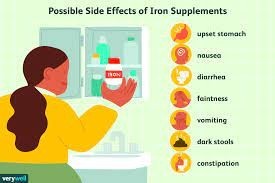A nurse is reviewing laboratory values for a client who is at 34 weeks of gestation. Which of the following findings should the nurse report to the provider?
Hgb 13.2 g/dL
BUN 15 mg/dL
Urine protein 3+
Fasting blood glucose 72 mg/dL
The Correct Answer is C
Proteinuria can indicate kidney dysfunction or potential complications in pregnancy, such as preeclampsia. The provider needs to be aware of this finding and may want to assess the client further and consider appropriate interventions.
The other laboratory values are within normal ranges and do not require immediate reporting. Hgb (hemoglobin) of 13.2 g/dL is within the normal range for pregnancy. BUN (blood urea nitrogen) of 15 mg/dL is within the normal range, indicating normal kidney function. Fasting blood glucose of 72 mg/dL is within the normal range and indicates normal blood sugar levels.
Nursing Test Bank
Naxlex Comprehensive Predictor Exams
Related Questions
Correct Answer is C
Explanation
Iron supplementation commonly causes constipation, which is due to the iron's effect of slowing down bowel movements and increasing water absorption in the intestines.
Dry mouth is not a common adverse effect of iron supplementation. It is more commonly associated with medications that can cause xerostomia (dry mouth), such as certain antihistamines or anticholinergic drugs.
Tinnitus, a perception of ringing or noise in the ears, is not typically associated with iron supplementation. Tinnitus can be caused by various factors, such as exposure to loud noises, ear infections, or certain medications, but it is not directly related to iron supplementation.
Hematuria, the presence of blood in the urine, is not a common adverse effect of iron supplementation. It can be caused by various conditions affecting the urinary system, such as urinary tract infections, kidney stones, or bladder issues, but it is not directly related to iron supplementation.

Correct Answer is C
Explanation
An incident report is a formal document used to report any unexpected or adverse events that occur during patient care. In this case, the administration of an incorrect dosage is an incident that should be documented in the incident report. The incident report serves as a record of the event and helps to ensure that appropriate follow-up actions are taken to prevent similar incidents in the future. It is important to note that an incident report is not part of the client's permanent medical record and is kept separate from other documentation.
The provider's progress notes, nursing care plan, and controlled substance inventory record are not appropriate locations to document this specific incident. The provider's progress notes are typically used to document the client's medical history, examination findings, treatment plans, and progress. The nursing care plan is a document that outlines the client's nursing diagnoses, goals, and interventions. The controlled substance inventory record is used to track and document the dispensing and administration of controlled substances, but it does not typically include incident reporting.
Whether you are a student looking to ace your exams or a practicing nurse seeking to enhance your expertise , our nursing education contents will empower you with the confidence and competence to make a difference in the lives of patients and become a respected leader in the healthcare field.
Visit Naxlex, invest in your future and unlock endless possibilities with our unparalleled nursing education contents today
Report Wrong Answer on the Current Question
Do you disagree with the answer? If yes, what is your expected answer? Explain.
Kindly be descriptive with the issue you are facing.
